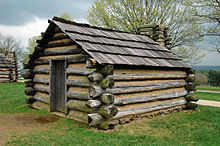Log Cabin
A log cabin ( German for "tree trunk log cabin" ) is a sub-form of the log cabin and describes a simple, one to one and a half-story wooden hut built from simply processed logs. Log cabins were built as the first dwelling, especially during the development of the North American continent by European settlers, as they were quick to erect. In North America, the term is therefore symbolically linked to terms such as originality and daring.
History and construction
The construction of the log cabins has its origins in Scandinavia and Central Europe . The corner connections are particularly important for the construction of wooden houses. In Europe, increasingly complex end connections and an extensive artisanal tradition had developed over the centuries. European settlers from these regions were able to fall back on this centuries-old tradition of using wood for houses and barns. The construction method was particularly popular in the north and in mountainous regions of North America, where winter conditions were often extreme because this construction method offered relatively good protection from the cold.
When settling the country, the settlers often had very good building materials at their disposal. Whenever possible, they used straight-stemmed trees, as this reduced the amount of work involved in building the hut. The size of the log cabins was often limited by the length of the trunk, even if that was not a limit for more experienced people. Most of the settlers, however, did not have extensive carpentry experience and only had relatively primitive tools at their disposal. Gaps between the horizontally lying tree trunks were filled with stones, moss and clay. Very primitive log cabins had a ground floor. Most log cabins have a wooden floor inside. In these log cabins, the corner connections were often placed on large stones. If the log cabin was relatively large, stones were also found in other places under the first, horizontally lying log.
Usually the settlers only used the log cabin during the first phase of clearing their land. In the years that followed, they often built a larger house using wood that was significantly more processed. The original log cabin was then mostly used as a cattle shed or storage room.
symbolism
Since the early 19th century, the log cabin has symbolized a humble beginning. Seven of the US presidents were born in a log cabin, including Abraham Lincoln , Andrew Jackson and James Buchanan . Although William Henry Harrison was not born in a log cabin, he and his party were the first to use the term log cabin during the election campaign to symbolize that he was a man of the people. Other candidates took up this topic in later election campaigns.
literature
- Harvey Green: Wood - Craft, Culture, History . Penguin Books, New York 2006, ISBN 978-0-14-311269-3
- CA Weslager: The log cabin in America; from pioneer days to the present . Rutgers University Press, New Brunswick, NJ 1969.
Web links
Individual evidence
- ↑ Log Cabins in America , National Park Service Teaching with Historic Places Lesson Plan, accessed 25 Feb 2016
- ↑ Wishart, D. Encyclopedia of the Great Plains , University of Nebraska Press, 2004 ISBN 0803247877
- ↑ Thépaut R. Round timber in construction: An introduction Report prepared for the UK Forestry Commission, TRADA Technology Ltd 2003 (pdf)
- ^ Harvey Green: Wood - Craft, Culture, History . Penguin Books, New York 2006, ISBN 978-0-14-311269-3 , p. 62
- ^ "President's Park (White House)" , National Park Service, accessed 2 Jul 2008

